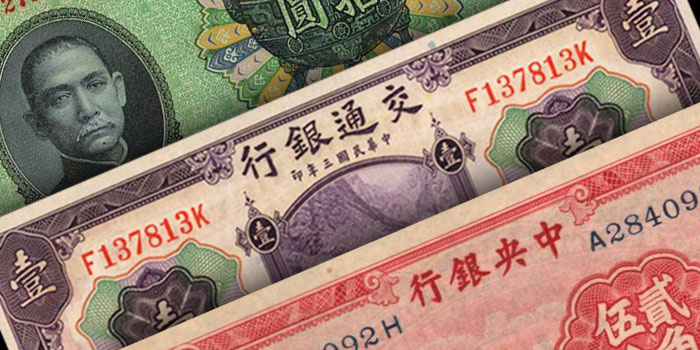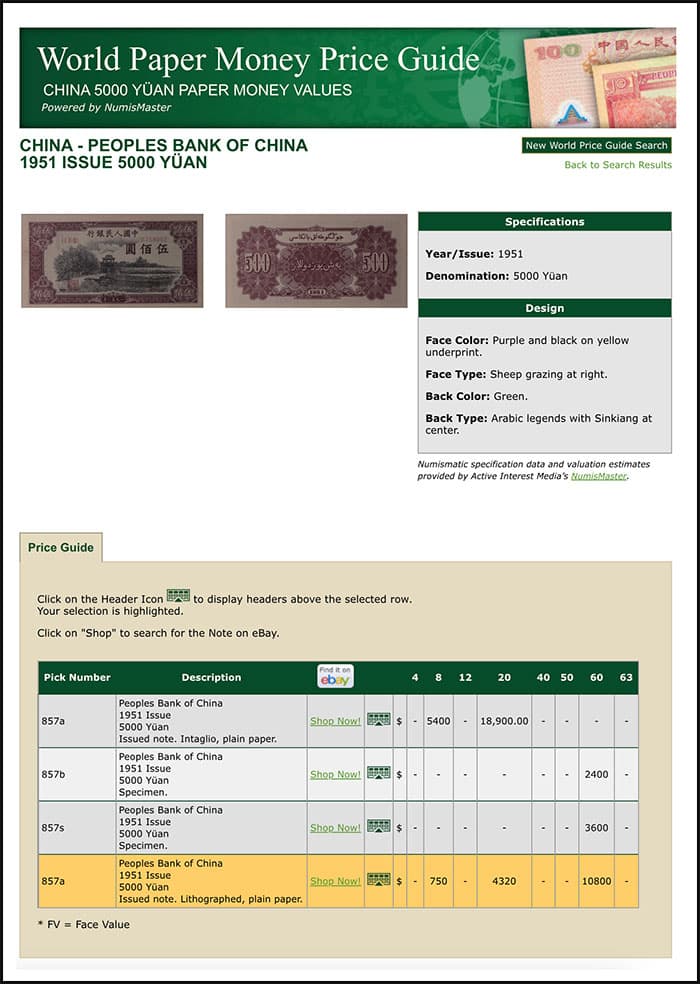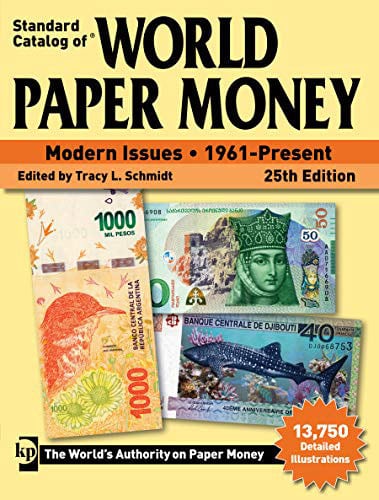Collecting Rare Pre-1950 Chinese Currency by Dr. Richard S. Appel – UniqueRareCoins.com ……
Part I | Part II | Part III | Part IV | Part V | Part VI
* * *
For decades, some Republic of China (1912-49) banknotes displaying unusual inscriptions were seldom seen or reported. From experience, only a few dedicated, long-time collectors and dealers recognized these important but overlooked notes. Similar but known rarities desired by collectors were primarily limited to early banknotes indicating their rare locations of issue. When one surfaced, bidding wars often resulted. Most of the limited collectors at the time were only interested in the different types, but that is beginning to change.

I discussed in my last article how the desires and interests of collectors evolve over time. China is a good example because banknote collecting is still in its relative infancy. Until the past 20 years, few Chinese Citizens had the excess income to use for their collections. Most were very poor and more concerned with the survival of themselves and their families. Today, their much-improved financial condition has allowed the number of Chinese collectors to swell to multiples of only a few short years ago.
In the beginning stages of a country’s development, a few collectors typically strive to acquire one example of each banknote and are drawn to better condition and attractive examples. Subtle differences in similar notes are of little concern to them. Later, as they become more knowledgeable, they begin to recognize dissimilarities. Their interest intensifies when they realize some banknotes are far rarer than others even though they look almost identical.
With Republic of China (ROC) emissions, notes that were issued by certain cities, provinces, banks, various printing factories, or display rare official signatures may be quite rare. Some may possess overprints, or control numbers or characters. These indicate their origin of manufacture and often their limited locations of use. Or, unusual color or some other important historical attribute may attest to their desirability and rarity. Eventually, collectors covet these notes to complete their collections. Then, competition becomes increasingly intense, and prices begin to rise. I believe this is the current stage of the ROC’s paper money market.
The major driving forces motivating collectors of all kinds are completing a series that interests them and possessing objects that few others can. Some seldom-seen Republic of China banknotes fit into this latter category. In fact, some are so rare they can be compared with the great rarities of any nation! I noted in earlier articles the primary reason ROC banknotes are far scarcer than one would expect. The Republic of China’s government was involved in wars with not only the Chinese Communists but also the Japanese. Shortly after Chiang Kai-shek assumed leadership of the Republic in 1927, he initiated a purge of his Communist opposition. Later, in 1937, Japan attacked and occupied a large part of China until the end of World War II.
The funding for the dual wars by the Republic was primarily done via printing press. Over time, the Chinese People were forced to helplessly watch as their money became virtually worthless through inflation. Finally, In 1949, Mao Zedong’s Communists overthrew the Republican government and seized all of China. With the stroke of a pen, they canceled the Republic of China’s coins and currency that citizens were dependent upon for their normal course of business and their futures. Literally overnight, wealthy individuals became poor, and the common person became destitute.
Great despair spread throughout the country. People burned, trashed, discarded, and otherwise destroyed virtually all the Republic of China banknotes they possessed. They kept most of the coins because they were at least worth their metal content.
The Chinese People wanted nothing to remind them of the misery and despair they endured and were expecting in their future. Many of the rarer notes only exist because they were taped in books or attached to walls. Or they were stowed away and forgotten. Many show signs of being burned or otherwise purposely damaged. Unsurprisingly, some notes are unknown in Uncirculated condition, and even a Fine or Very Fine example is an important discovery.
In June 1937, one U.S. dollar was worth 3.7 yuan. As the yuan depreciated by December 1941, a dollar would buy 18.9 yuan. The yuan continued to rapidly decline in value, and at the end of 1945, it required 1,220 yuan to purchase one dollar. Finally, inflation skyrocketed seemingly without limit. After Japan retreated, the desperate attempt by the Republic’s government to conquer the Communists resulted in an incredible increase in their money supply. An unbelievable 23.3 million yuan was needed to acquire one lonely U.S. dollar. Citizens truly required a wheelbarrow full of currency to purchase a loaf of bread.
The PMG Population Report

Founded in 2005, Paper Money Guaranty (PMG) is the largest and most respected worldwide, independent paper money authentication and grading service. Earlier, there was no central location reporting the relative rarity of each banknote in a series. Collectors and investors were primarily limited to their individual experience. PMG’s Population Report (POP Report) lists every banknote they have examined and is freely available to all. At this writing, PMG has encapsulated over seven million banknotes from countries around the world. The Chinese notes are far and away the most widely collected, with 3.7 million specimens for all years. This attests to the great collector interest of the Chinese.
Fortunately for the banknote collecting fraternity, PMG has recorded and tabulated their experience into an easily utilized report. It lists their totals and number in each grade for every banknote in Pick’s, The Standard Catalogue of World Paper Money. Each note is listed by their Pick number. The POP Report goes a long way to rivaling years of experience and research by thousands of dedicated collectors and dealers into minutes of use.

All Republic of China banknotes are far scarcer than one would expect given what once existed. Notes that are considered common today that were issued in the millions, may have only thousands remaining. Some limited issues may have been virtually or possibly completely destroyed.
The random destruction of most ROC notes has left many surprises. Given the PMG POP Report has years of information, it exposes many heretofore unrecognized rarities. In fact, certain issues that have very low valuations in the major price guides currently show five or fewer, or even zero, counts in the POP Report. This does not mean they are unique, but it indicates they are far scarcer and more desirable than generally believed, and are potentially extremely rare. Additionally, some notes are unpriced above Fine condition showing the poor condition in which they are found.
 To date, the popular price guides value many relatively unrecognized scarce and rare ROC notes at far lower prices than they trade. It is not uncommon for some to be listed at similar prices as the more common ones of their type. Fortunately for collectors, PMG’s POP Report exposes many of these errors.
To date, the popular price guides value many relatively unrecognized scarce and rare ROC notes at far lower prices than they trade. It is not uncommon for some to be listed at similar prices as the more common ones of their type. Fortunately for collectors, PMG’s POP Report exposes many of these errors.
A quick perusal allows any interested person the ability to compare the relative rarity of one note with another. It is not perfect, because more notes will be authenticated over time, but it goes a long way to uncover some great rarities that are currently hidden.
Chinese and worldwide collectors are increasingly beginning their collections of Republic of China banknotes. They are either attempting the impossible task of building a complete set, or one of different cities, provinces, banks, or other areas of interest. Today, more are including the lesser-known and scarcer notes. I believe as the recognition and quest for these presently unsung rarities grows it will enhance the future and excitement for Republic of China banknote collecting in general.
* * *




